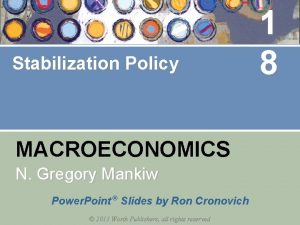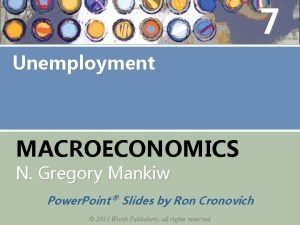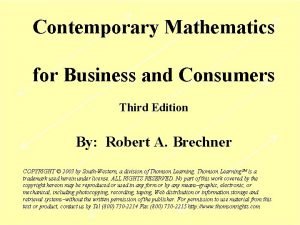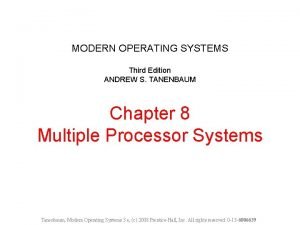PRINCIPLES OF ECONOMICS Third Edition Oxford Fajar Sdn
























- Slides: 24

PRINCIPLES OF ECONOMICS Third Edition © Oxford Fajar Sdn. Bhd. (008974 -T), 2013 All Rights Reserved 3– 1

CHAPTER 3 MARKET EQUILIBRIUM PRINCIPLES OF ECONOMICS Third Edition © Oxford Fajar Sdn. Bhd. (008974 -T), 2013 All Rights Reserved 3– 2

DEFINITION OF MARKET EQUILIBRIUM A market equilibrium is a situation when quantity demanded and quantity supplied are equal and there is no tendency for price or quantity to change. QDD = QSS PRINCIPLES OF ECONOMICS Third Edition © Oxford Fajar Sdn. Bhd. (008974 -T), 2013 All Rights Reserved 3– 3

Market equilibrium is the state in which market supply and market demand balance each other, resulting in stable prices. q It can also be said another way, which is when the amount of goods or services sought by buyers is equal to the amount of goods or services produced by sellers. q PRINCIPLES OF ECONOMICS Third Edition © Oxford Fajar Sdn. Bhd. (008974 -T), 2013 All Rights Reserved 3– 4

When a market is in equilibrium, the quantity sellers are willing to sell balances exactly with the quantity buyers are willing to buy. q Market equilibrium is determined by the intersection of both the demand supply curves. q PRINCIPLES OF ECONOMICS Third Edition © Oxford Fajar Sdn. Bhd. (008974 -T), 2013 All Rights Reserved 3– 5

EQUILIBRIUM PRICE AND OUTPUT SURPLUS (QSS > QDD) 6 Price 5 4 3 E SS P* 2 DD SHORTAGE (QDD > QSS) 1 0 2 4 PRINCIPLES OF ECONOMICS Third Edition © Oxford Fajar Sdn. Bhd. (008974 -T), 2013 Q* 6 Quantity 8 10 All Rights Reserved 3– 6

EQUILIBRIUM PRICE AND OUTPUT Price Quantity Demanded Quantity Supplied Market Condition Market Prices 5 2 10 SURPLUS Falls 4 4 8 SURPLUS Falls 3 6 6 EQUILIBRIUM Equilibrium 2 8 4 SHORTAGE Rises 1 10 2 SHORTAGE Rises PRINCIPLES OF ECONOMICS Third Edition © Oxford Fajar Sdn. Bhd. (008974 -T), 2013 All Rights Reserved 3– 7

CHANGES IN DEMAND Assume supply is constant Increase in Demand Price (RM) -DD curve shifts to the right SS -Equilibrium price and quantity increase P 2 P* DD 1 P 1 DD 2 Decrease in Demand -DD curve shifts to the left -Equilibrium price and quantity decrease DD Q 1 PRINCIPLES OF ECONOMICS Third Edition © Oxford Fajar Sdn. Bhd. (008974 -T), 2013 Q* Q 2 Quantity All Rights Reserved 3– 8

CHANGES IN SUPPLY Assume demand is constant Price (RM) Increase in Supply SS 2 -SS curve shifts to the right SS -Equilibrium price decreases and quantity increases P 2 SS 1 P* P 1 DD Decrease in Supply -SS curve shifts to the left -Equilibrium price increases and quantity decreases Q 1 PRINCIPLES OF ECONOMICS Third Edition © Oxford Fajar Sdn. Bhd. (008974 -T), 2013 Q* Q 2 Quantity All Rights Reserved 3– 9

CHANGES IN BOTH DEMAND SUPPLY AND DEMAND BOTH INCREASE Price (RM) Case 1: Same magnitude DD 1 -Equilibrium price is constant and quantity increases SS SS 1 P* DD Q* PRINCIPLES OF ECONOMICS Third Edition © Oxford Fajar Sdn. Bhd. (008974 -T), 2013 Q 1 Quantity All Rights Reserved 3– 10

CHANGES IN BOTH DEMAND SUPPLY (cont. ) SUPPLY AND DEMAND BOTH INCREASE Case 2: Different Magnitude Price (RM) DD 1 SS SS 1 P 1 -Equilibrium price increases and quantity increases P* DD Q* PRINCIPLES OF ECONOMICS Third Edition © Oxford Fajar Sdn. Bhd. (008974 -T), 2013 Q 1 Quantity All Rights Reserved 3– 11

CHANGES IN BOTH DEMAND SUPPLY (cont. ) SUPPLY AND DEMAND BOTH INCREASE Case 3: Different Magnitude Price (RM) DD 1 -Equilibrium price decreases and quantity increases SS SS 1 P* P 1 Both DD and SS increase è Equilibrium quantity increase è Equilibrium price is uncertain DD Q* PRINCIPLES OF ECONOMICS Third Edition © Oxford Fajar Sdn. Bhd. (008974 -T), 2013 Q 1 Quantity All Rights Reserved 3– 12

CONSUMER SURPLUS Price of concert ticket 80 CONSUMER SURPLUS Difference between what a consumer is willing to pay and what is actually paid. A The area of the triangle ABC which is the area under the demand curve and above the equilibrium price of RM 40 is the CONSUMER SUPRLUS. 60 CONSUMER SURPLUS 40 C B Consumer Surplus = ½ * (80 -40)*2=RM 40 20 DD 0 1 2 PRINCIPLES OF ECONOMICS Third Edition © Oxford Fajar Sdn. Bhd. (008974 -T), 2013 3 4 Quantity of concert ticket All Rights Reserved 3– 13

PRODUCER SURPLUS Price of concert ticket SS 80 The area of the triangle DEF which is the area above the supply curve and below the equilibrium price of RM 40 is the PRODUCER SUPRLUS. 60 40 PRODUCER SURPLUS Difference between what a producer is paid and what he/she is willing to sell. E F Producer Surplus = ½ * (40)*2=RM 40 PRODUCER SURPLUS 20 0 D 1 2 3 PRINCIPLES OF ECONOMICS Third Edition © Oxford Fajar Sdn. Bhd. (008974 -T), 2013 4 Quantity of concert ticket All Rights Reserved 3– 14

MARKET EFFICIENCY Price of concert ticket SS 80 ECONOMIC EFFICIENCY The allocation of resources maximizes total surplus (consumer surplus producer surplus) which received by the society. Consumer Surplus (CS) = area above equilibrium price and below demand curve 60 CONSUMER SURPLUS Producer Surplus (PS) = area below equilibrium price and above supply curve 40 PRODUCER SURPLUS Total Surplus (TS) = CS + PS 20 0 1 2 3 PRINCIPLES OF ECONOMICS Third Edition © Oxford Fajar Sdn. Bhd. (008974 -T), 2013 4 Quantity of concert ticket All Rights Reserved 3– 15

MAXIMUM PRICE MINIMUM PRICE GOVERNMENT INTERVENTION IN THE MARKET TAXES PRINCIPLES OF ECONOMICS Third Edition © Oxford Fajar Sdn. Bhd. (008974 -T), 2013 SUBSIDIES All Rights Reserved 3– 16

GOVERNMENT INTERVENTION IN MARKETS Price Advantage: • Consumers purchase at lower price MAXIMUM PRICE/CEILING PRICE Government-imposed regulations that prevent prices from rising above a maximum level S Suppliers reduce the amount offered to Q 1 but demand would rise to Q 2 creating a shortage The equilibrium price is P* and the quantity is Q* P* The government imposes a maximum price of P 1 Price ceiling P 1 Shortages occur D Q 1 Q* Q 2 PRINCIPLES OF ECONOMICS Third Edition © Oxford Fajar Sdn. Bhd. (008974 -T), 2013 Disadvantages: • Emergence of black market • Reduction in quantity produced • Producers tend to receive illegal payments from consumers Quantity All Rights Reserved 3– 17

GOVERNMENT INTERVENTION IN MARKETS (cont. ) Price MINIMUM PRICE/FLOOR PRICE Government-imposed regulations that prevent prices from falling below a minimum level S Surplus occurs Advantages: P 1 • Protects the producer’s income Floor Price P* • Higher wage rate Disadvantages: • Consumers pay more • Waste of resources of production • Creates unemployment Q* Q 2 PRINCIPLES OF ECONOMICS Third Edition © Oxford Fajar Sdn. Bhd. (008974 -T), 2013 The equilibrium price is P* and the quantity is Q*. The government imposes a minimum price of P 1 D Q 1 Suppliers increase the amount offered to Q 2 but demand drop to Q 1 creating a surplus Quantity All Rights Reserved 3– 18

EFFECT OF TAXATION S 1 Price ax T = RM 4 INDIRECT TAX S Tax that is imposed by the government on producers or sellers but paid by or passed on to end-users The equilibrium price is RM 12 and the quantity is 400 14 12 10 CONSUMER’S SHARE The government imposes a sales tax of RM 4 per carton PRODUCER’S SHARE SS curve shift to left from S to S 1 and new equilibrium is RM 14 and 200 units The tax amount of RM 4 is shared equally between buyer and seller D 200 400 PRINCIPLES OF ECONOMICS Third Edition © Oxford Fajar Sdn. Bhd. (008974 -T), 2013 Quantity All Rights Reserved 3– 19

Perfectly inelastic demand P D S + tax S 16 12 CONSUMERS’ SHARE 400 O Demand is more elastic than supply P S + tax Q Incidence of tax: elastic supply P S + tax S 13 12 S 121 PRODUCERS’ CONSUMERS' SHARE D SHARE 18 PRODUCERS’ SHARE D 9 O 400 Q PRINCIPLES OF ECONOMICS Third Edition © Oxford Fajar Sdn. Bhd. (008974 -T), 2013 O 400 Q All Rights Reserved 3– 20

EFFECT OF SUBSIDIES 10 S Price i dy s ub S = RM S 1 SUBSIDY An incentive from the government to encourage producers to produce more The equilibrium price is RM 50 and the quantity is 10 50 45 40 CONSUMER’S SHARE The government provides a subsidy of RM 10 per unit PRODUCER’S SHARE SS curve shifts to the right from S to S 1 and new equilibrium is RM 45 and 20 units The subsidy amount of RM 10 is shared equally between buyer and seller D 10 20 PRINCIPLES OF ECONOMICS Third Edition © Oxford Fajar Sdn. Bhd. (008974 -T), 2013 Quantity All Rights Reserved 3– 21

EFFECT OF PRICE ELASTICITY ON SUBSIDIES Demand is more elastic than supply P P S S+ tax (RM 4) 50 S + tax 50 47 Demand less elastic than supply S CONSUMERS’ SHARE CONSUMERS'S SHARE 43 PRODUCERS ’ SHARE 40 PRODUCERS’SHARE D 40 D O 10 PRINCIPLES OF ECONOMICS Third Edition © Oxford Fajar Sdn. Bhd. (008974 -T), 2013 Q 0 10 Q All Rights Reserved 3– 22

MARKET FAILURE Market failure exists when a free market is unable to deliver an efficient allocation of resources which leads to a loss of economic efficiency. q Causes of market failure – Externalities – Existence of monopoly power – Public goods – Incomplete information q PRINCIPLES OF ECONOMICS Third Edition © Oxford Fajar Sdn. Bhd. (008974 -T), 2013 All Rights Reserved 3– 23

q q Externalities: costs or benefits received by the third parties that are not directly involved in the economic transaction - negative externalities: refer to the external costs for the society; social cost higher than the private cost - positive externalities: the external benefits for the society; social benefit higher than the private benefit Monopoly power: market power to control the quantity and price of goods Public goods: goods provided for everyone - non-excludable: the inability of producers to earn profit from the good - non-rival: the consumption of the good by one person cannot preclude the consumption of that good by another person. Inadequate information: consumers do not have adequate information about prices and quality of the product. PRINCIPLES OF ECONOMICS Third Edition © Oxford Fajar Sdn. Bhd. (008974 -T), 2013 All Rights Reserved 3– 24
 Principle of economics third edition
Principle of economics third edition Oxford fajar sdn bhd
Oxford fajar sdn bhd Organizational behaviour oxford fajar pdf
Organizational behaviour oxford fajar pdf Organizational behaviour oxford fajar pdf
Organizational behaviour oxford fajar pdf Financial management oxford fajar
Financial management oxford fajar Principles of economics mankiw 9th edition ppt
Principles of economics mankiw 9th edition ppt Rational people think at the margin
Rational people think at the margin Principles of economics mankiw 9th edition ppt
Principles of economics mankiw 9th edition ppt Adrian cooper oxford economics
Adrian cooper oxford economics How robots change the world oxford economics
How robots change the world oxford economics Forward caries definition
Forward caries definition Forward caries and backward caries
Forward caries and backward caries Organic chemistry third edition david klein
Organic chemistry third edition david klein Organic chemistry third edition david klein
Organic chemistry third edition david klein Business mathematics third edition
Business mathematics third edition Modern operating systems tanenbaum
Modern operating systems tanenbaum Fundamentals of corporate finance third canadian edition
Fundamentals of corporate finance third canadian edition Fundamentals of corporate finance, third canadian edition
Fundamentals of corporate finance, third canadian edition Lifespan development third edition
Lifespan development third edition Lifespan development third edition
Lifespan development third edition Essential cell biology
Essential cell biology Joey's first 14 quiz grades in a marking period were
Joey's first 14 quiz grades in a marking period were Using mis 10th edition
Using mis 10th edition Zulily case study
Zulily case study Modern labor economics 12th edition solution
Modern labor economics 12th edition solution










































